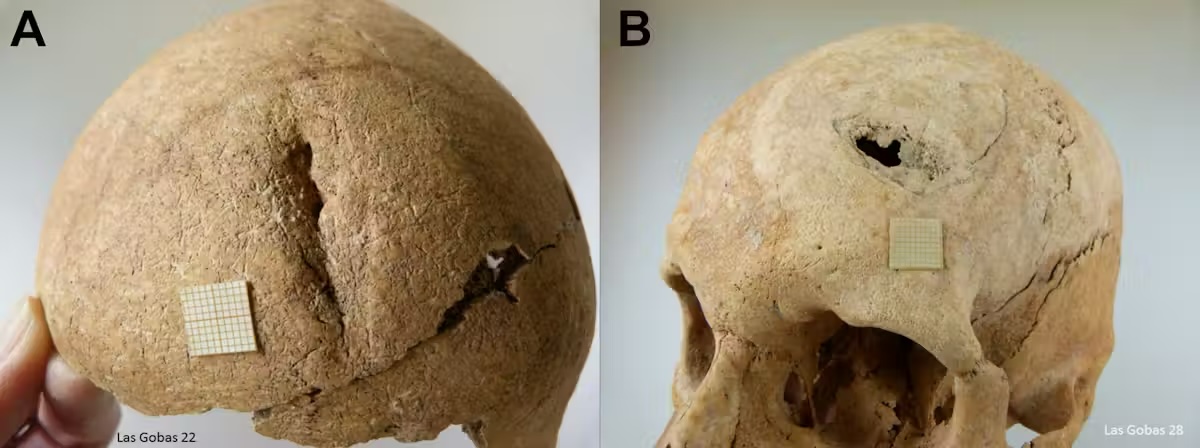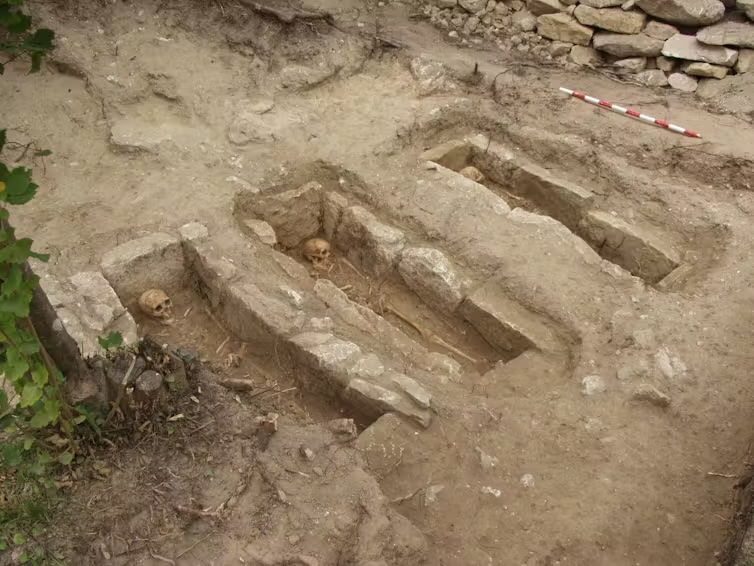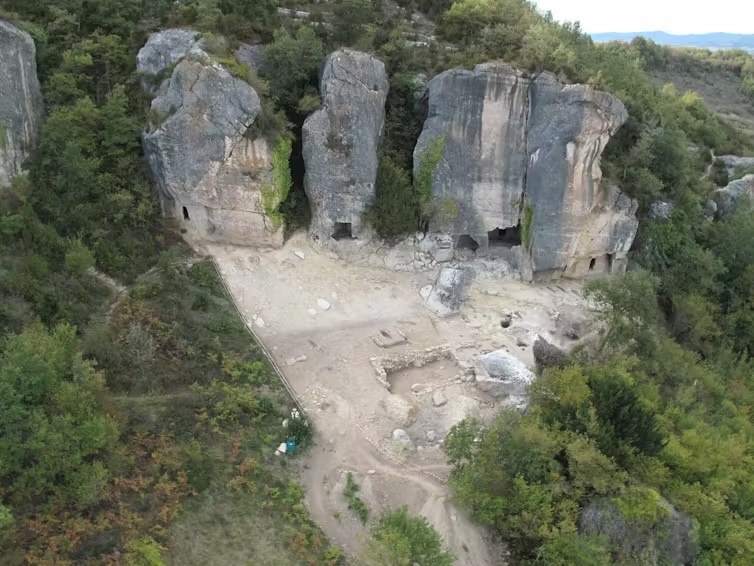DNA reveals inbreeding, smallpox and violent ends among cave-dwelling Christians in medieval Spain
It's unclear why people chose to live in the caves, but DNA is shedding light on their lives.

In a new study, we have sequenced DNA from a Christian community in medieval Spain that lived in artificial caves carved into a rocky outcrop.
This is one of several medieval cave communities known to have lived on the Iberian peninsula – which includes both Portugal and Spain. Why these groups favored caves over more conventional village dwellings is a subject of longstanding debate for archaeologists. While it may be tempting to speculate about hermits or religious groups, there’s scant evidence to support such theories.
Our study, published in Science Advances, explores the possibilities, adding genetic analysis to what we know about the physical remains of people from the site’s cemetery. DNA was able to shed light on the ancestry of this community, their relationships to each other and the diseases that afflicted them.
The combined information reveals a story of inbreeding, occasional bouts of violence and disease during a fascinating period in history. One possibility is that some of the earliest settlers were people with military experience, though it’s unclear whether they were professional soldiers or not.
The settlement existed from the mid-sixth century to the 11th century A.D. The early middle ages was a dynamic and tumultuous era in many parts of Europe, including the Iberian peninsula. After the fall of the western Roman empire in A.D. 476, Iberia came under the rule of the Visigoths, who came from northern Europe.
The Visigothic kingdom collapsed following a conquest by Muslim armies crossing from North Africa in A.D. 711. This event established a territory known as Al-Andalus which, at its greatest extent, covered much of Iberia. But Christian kingdoms persisted in the north of the peninsula and gradually reclaimed territory.
Related: Vast Goth cemetery brimming with grave goods and ornate silver jewelry discovered in Poland
Get the world’s most fascinating discoveries delivered straight to your inbox.
What we know about the period in this part of the world has been dominated by events in Iberia's major cities at the time, such as Toledo, Granada and Cordoba. These were hubs of trade, diplomacy and power.

The rural site of Las Gobas offers a glimpse into life away from these urban centres, in one of the distinctive cave-dwelling communities known from this period.
Located in Burgos province, northern Spain, near the village of Laño, Las Gobas features a cemetery that was used continuously from the seventh to the 11th century. It was initially connected to a church, also built within the cave complex. By the tenth century, the inhabitants had moved to a more typical rural village, though the cave church and cemetery remained in use until the 11th century.
Archaeological excavations at the cemetery have uncovered the remains of 41 people. We subjected 39 of them to genetic analysis, and 33 provided enough DNA for sex identification (22 males and 11 females). Some 28 remains yielded enough DNA for further investigation with a variety of genetic techniques.
Sword blows
First, we found that the inhabitants were overwhelmingly of local Iberian ancestry with very minimal contribution from North Africans — despite their proximity to the northern edge of Al-Andalus.
This aligns with historical records indicating limited genetic influence from North African populations in northern Iberia during the middle ages. Nonetheless, some migration did occur, evidenced by several people with higher North African ancestry after the Muslim conquest.
Two of the skeletons dating to the early phase of settlement exhibited signs of violence, which probably resulted from sword blows to the head. The two individuals were genetically closely related. Amazingly, one of them survived an injury that cut through the skull. These skeletons, however, come from a time before the Muslim conquest, so their injuries were not caused by conflicts along the Al-Andalus border.
This period saw elevated levels of inbreeding, with approximately 61% of the sample where there was enough genomic data to analyse showing signs of inbreeding (14 out of 23). This suggests that the population at this time practised endogamy — marrying only within the community.

Together with the evidence for inbreeding, we can see that several of the earliest males are close kin because there are only relatively small variations observed in their Y-chromosome (a package of genetic material passed from father to sons). This suggests that the site could have been populated in the seventh century A.D. by a small patrilocal (where couples settle in the husband's home or community) group that may have had experience of warfare.
The early phase of the Las Gobas settlement also revealed several cases of the bacterium Erysipelothrix rhusiopathiae, which causes a skin disease in humans. More interestingly, the bacterium often originates in domestic animals. The bacterium was also present in the settlement's latter phase, but at a lower frequency.
Smallpox source
The presence of this bacterium, commonly found in pigs, suggests that keeping these livestock animals was an essential part of the community's lifestyle. Furthermore, one of the people infected with E. rhusiopathiae was also carrying Yersinia enterocolitica, a bacterium known to infect humans through bad meat or bad water.
Endogamy remained a strong feature throughout the population's history, even as the community transitioned from cave dwellings to a more typical rural settlement in the tenth century. During this later phase, we detected DNA from the variola virus, responsible for smallpox, in a tenth-century individual.

Smallpox, with its high mortality rate (30% without vaccination), has been suggested by some researchers to have reached Iberia via the Muslim conquest. However, the Las Gobas smallpox strain resembled those found in Scandinavia, Russia and Germany during the same period. Therefore, it appears as if at least one pandemic route was from the east.
Increased mobility, exemplified by the growing importance of the northern city of Santiago de Compostela for Christian pilgrims in the ninth and tenth centuries, may even have helped spread the virus. In all these ways, Las Gobas stands out as a unique site spanning the turbulent early medieval period in Iberia.
It reveals a community marked by isolation, violence and devout worship. What started as a cave-dwelling group evolved into a typical rural village that endured its share of disease. As such, the site offers a rare and detailed glimpse into the lives of people whose stories are often eclipsed by history told from the perspective of major urban centres and their elites.
This edited article is republished from The Conversation under a Creative Commons license. Read the original article.

I have my background in scientific archaeology and did my Ph.D. at the Archaeological Research Laboratory at Stockholm University in the 90's. And although I do have some early experience from archaeological excavations and field work, I was always conducting my archaeology in the laboratory, with genetics. Through out my career I have worked at Uppsala University and Universidad Complutense de Madrid after i concluded my Ph.D. and before I came back to Stockholm University. My research has mainly focused on prehistoric humans and what we can learn about them and their lives with the help of archaeogenetic.


